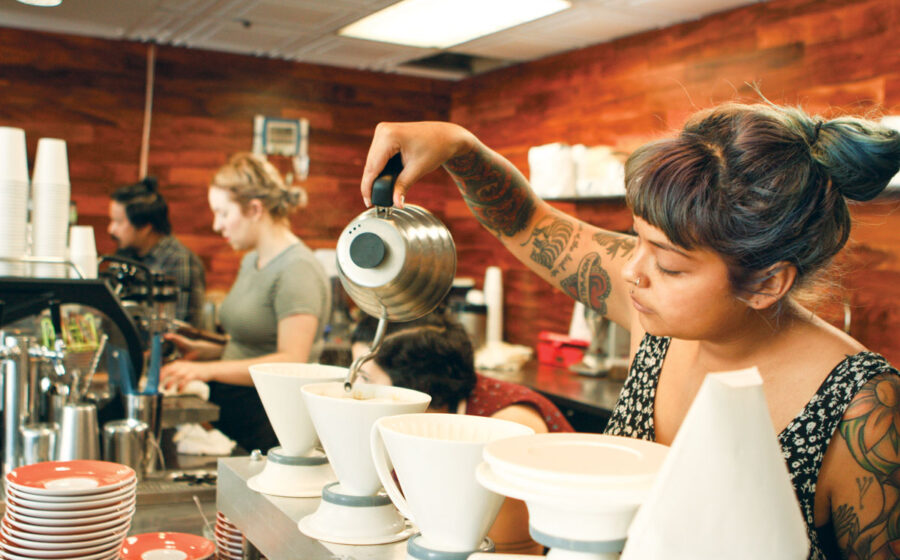[W]hen the Silicon Valley coffee company they worked for was sold to new owners, James Warren and his colleagues decided it was time to take the skills they had learned in their cumulative coffee careers—which were valuable and varied—and launch something all their own.
In 2012, Warren and several co-workers said goodbye to their employers, took the café they’d been working in (which Warren and his sister Wendy had recently acquired) and rebuilt the business. In the new-old space, Chromatic Coffee soon began sourcing, roasting, and brewing in ways that were collaborative with producers and reflective of their dedication to coffee and their customers. They hired folks with ideas congruent to their own, and the list of co-owners soon grew. Between its San Jose roastery and its Santa Clara café, today Chromatic counts six co-owners, and, true to its location in California’s innovation epicenter, boasts some of the most cutting-edge roasting and brewing techniques in the country.
The wow factor of this South Bay roastery isn’t immediately evident when you arrive at the shop, an unassuming storefront nestled in a strip mall on a boulevard populated with big box stores and restaurant chains. Inside, a bar wrapped in dark wood draws you into the shop’s coffee geekery, as do long wall-mounted shelves that house brewing equipment and single-origin beans in black-and-white bags bearing the company’s signature, hand-drawn and house-stamped labels. Nothing is overly flashy—but as Warren says, it’s what’s on the inside that counts.
“I just like things that are internally bulletproof,” he says, referring to his background as a coffee machine tech. The real magic of Chromatic happens out of sight, in the roasting processes and mind of roaster and co-owner Hiver van Geenhoven, and within the insides of the shop’s La Marzocco Strada, carefully modified by Warren. Van Geenhoven’s brainchild, a roasting project integrating the science of water quality, comes to life behind the bar, where the three-boiler Strada Warren plumbed to multiple water sources allows baristas to highlight coffees by brewing with different waters on the same machine. You don’t have to be a scientist to understand how the process works—but you do have to pay pretty close attention.
The Radio project, named after San Jose’s original radio tower and station, built in 1909 and the first of its kind in the country, came to van Geenhoven at a Roaster’s Guild event several years ago. In talking to other roasters he realized many, if not most, were roasting their coffees to pair well with the water available to them. Whether hard or soft, their regional water’s makeup was a major factor in how they treated different beans. As he thought more about different coffees brewed in different waters yielding different results, he remembered a home-brewing project of Warren’s where he used mineral packets to replicate the water types used in a particular region’s beer styles. Putting the two concepts together, an experiment in water variation was born, bringing an underappreciated variable to the forefront of Chromatic’s coffee program.
“We realized that of all the variables that we tinker with endlessly—time, temperature, pressure—we were ignoring the craziest and most unknown one of all,” says van Geenhoven. “We started messing around with different compositions of water, and we started getting really desirable results.”

By isolating the Strada’s boilers and filtering the water to each grouphead, Chromatic is able to brew with multiple water types (ranging from twenty to 150 ppm), depending on the coffee. The SCAA standard is 150 ppm, already an impressive modification for Chromatic considering the area’s hard water. The Radio coffees are roasted to be brewed on the grouphead attached to the “super-low” TDS water, at a level more common in Scandinavian cafés, a region where roasting and water are deeply intertwined. “Turns out many of the roasts from around the world that we had originally thought to be undesirable, too dark or a little light, were really well developed when brewed with the water composition available to those places,” says van Geenhoven.

The do-it-yourself attitude of Chromatic, inherent in several employees’ decision to jump ship and make something new, continues to show up in almost everything Chromatic does. Down to the graphics for bags, drawn up and hot-stamped in house and designed on occasion by customers as part of an Artist Takeover Series, to the fierce attention to brewing variables (including water), the hand-modified and in some cases hand-built equipment, and the noticeable happiness of content baristas, the work Chromatic does—at origin, roasting, and in the café—is passionate, fair-minded, and imaginative. It’s all possible because of the company’s initial mission: to create a business worth staying at.
—Regan Crisp is Fresh Cup’s associate editor.

















